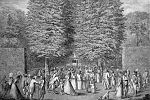Kleinbosischer garden
The Kleinbosische Garten (later Lehmanns Garten ) was one of the famous baroque gardens in historic Leipzig .
Location and shape
The Kleinbosischer Garten (also: Kleinbosescher Garten ) was located west of the fortified city in the floodplain of Pleiße and Weißer Elster , which was drained by ditches. It began on the west bank of the Pleißemühlgraben and extended to the west. The barefoot mill was also on the west bank of the mill and was enclosed by the garden and the mill. The thief's ditch flowed around the remaining three sides of the garden . In the north the Kleinbosische Garten bordered on the thief's ditch on Richter's garden and in the southwest on Apels garden . The shortest access from the city to the garden was through the barefoot gate .
In today's road network, the area is enclosed by Dittrichring, Käthe-Kollwitz-Straße, Thomasiusstraße with Nikischplatz and Zentralstraße.
The Kleinbosische Garten was divided into the pleasure garden and the meadow garden adjoining it to the north, both of which were separated by a ditch. The pleasure garden was reached via a bridge over the Pleißemühlgraben. At the entrance there was a two-story summer house, the orangery and a gardener's house. After a decorative square, an artistically designed gate on the central avenue led into the main part of the garden, which was strictly structured according to the French model. In the back it contained a large oval water basin with an island.
The meadow garden lined with fruit trees, following the thief's ditch, had an irregular shape. Nevertheless, a right-angled cross was inscribed on it too.
history
The Kleinbosische Garten was laid out by the Leipzig councilor Georg Bose from 1692. In that year he bought the site from the heirs of Christian Lorentz von Adlershelm . He had already acquired a piece of land behind the barefoot mill from the Johannishospital in 1639 and gradually enlarged it by buying neighboring properties.
The architect Leonhard Christoph Sturm contributed to the creation of the garden in the form described above . Georg Bose's brother Caspar had already had the garden in the Bose family property in Leipzig's eastern suburb designed as a baroque garden. To distinguish between the gardens, they were called the Greater Bosian and the Little Bosian Gardens according to their size .
The Kleinbosischer Garten remained in the possession of the Bose family for 60 years after the death of Georg Bose in 1700. After various changes of ownership and severe devastation during the Battle of Nations , the garden finally came into the possession of the piano dealer Christian Friedrich Lehmann through auction in 1829 and was henceforth called Lehmanns Garten . Hermann Gustav Lehmann inherited it as the last owner in 1854.
The Lehmanns built a magnificent mansion on the site of the former garden house, but the garden had long since lost its beauty over the years. In 1835, a four-story rental apartment building was built over the full length of the garden on the south side, the Long House , and the garden in front of it was divided into rental gardens. The northern part of the garden was used commercially and was called Barrack City or Leipzig San Francisco because of its lack of clarity and its provisional character .
In 1880, the Leipzig real estate company acquired a large part of Lehmanns Garten and prepared a development plan, which was approved by the city council in 1881. Now the development of the meadow garden began, which was followed by the front part, the former pleasure garden, at the end of the 19th and beginning of the 20th century. The former main avenue corresponds to the course of Bosestrasse. On the site of the Lehmann manor house, the Leipzig Life Insurance Company building was erected in 1908 and is now used by the Leipzig University of Music .
At the Kleinbosischen garden today by the Leipzig sculptor remember Markus glasses created faithful reproductions of two fencers figures on the Nikischplatz lying on former gardens.
literature
- Nadja Horsch, Simone Tübbecke (Ed.): Citizens. Gardens. Promenades - Leipzig garden culture in the 18th and 19th centuries. Passage Verlag, Leipzig 2018, ISBN 978-3-95415-072-4 , pp. 46–51.
- Johann Gottlob Schulz: Description of the City of Leipzig , Verl. AF Böhm Leipzig, 1784, p. 448–450 ( digitized version )
- Inner Westvorstadt - A historical and urban study . Published by PRO LEIPZIG 1998
- Horst Riedel: Stadtlexikon Leipzig from A to Z . PRO LEIPZIG, Leipzig 2005, ISBN 3-936508-03-8 , pp. 60/61
- Alberto Schwarz: Das Alte Leipzig - Stadtbild und Architektur , Beucha 2018, pp. 95–96, ISBN 978-3-86729-226-9 .
Web links
Individual evidence
- ↑ Stadtlexikon Leipzig from A to Z , p. 61
- ↑ According to Wolfgang Hocquél ( Leipzig, Architektur von der Romanik bis zur Gegenwart, Leipzig 1994, p. 285), Georg Bose certainly had the skills to design the garden himself.
- ↑ Inner Westvorstadt , p. 11
Coordinates: 51 ° 20 ′ 26 ″ N , 12 ° 22 ′ 8 ″ E








